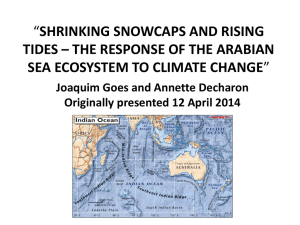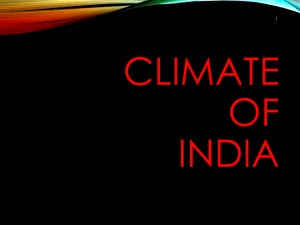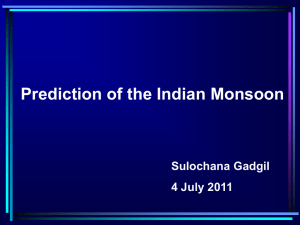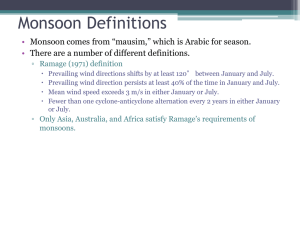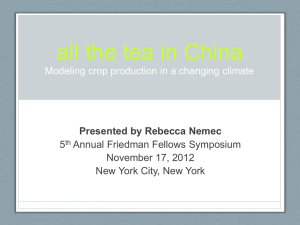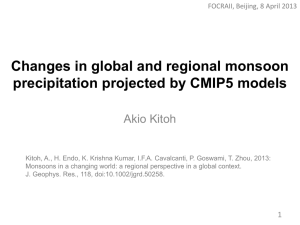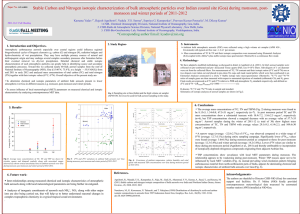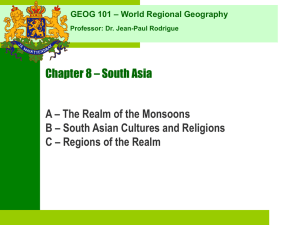What is a Monsoon?
advertisement
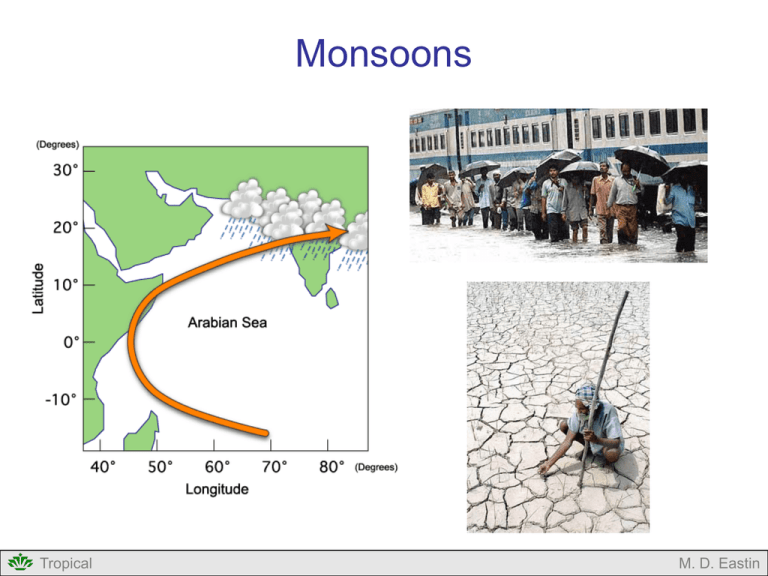
Monsoons Tropical M. D. Eastin Outline What is a Monsoon? Societal Impacts of Monsoons Indian Summer Monsoon (the Big One) Other Monsoons Tropical M. D. Eastin What is a Monsoon? Definition and Background • A monsoon is a wind circulation that reverse course on seasonal time scales • Associated are sharp seasonal contrasts in precipitation • The primary cause of monsoons are strong thermal contrasts between the land and sea [Edmond Halley (of comet fame) was first of recognize this forcing] Three major monsoon systems: • Asian-Australian (of which the Indian monsoon is the dominant component)** • African (influences easterly wave development during the summer) • American (of which the Southwest U.S. monsoon is a part) Common Characteristics: • Heavy summer rains and very dry winters • Seasonal wind reversals • Large cross-equatorial moisture flux from the winter hemisphere • Strongly influenced by terrain → elevated heat sources and ducted flow ** We will look at the Indian Monsoon in greatest detail Tropical M. D. Eastin Monsoon Impacts Large Societal Impact on Global Scale • Monsoonal regions cover roughly ½ of the Tropics (or ¼ of the global surface area) and plays host to ~65% of the world’s population Population Density American Monsoon African Monsoon Tropical Asian-Australian Monsoon M. D. Eastin Monsoon Impacts Large Societal Impact on Global Scale • Most agriculture and the economies of these regions are intimately tied to the monsoons • Interannual (and climatic) variability of monsoon “onset” and intensity can be catastrophic Tropical M. D. Eastin Indian Monsoon Dry Season Annual Variability • The dry season (Dec-Feb) is characterized by offshore flow toward the southwest • Deep convection is located in southern Indian Ocean • Precipitation over the continent is very minimal • The wet season (Jun-Aug) is characterized by strong onshore flow from the southwest • Precipitation is often intense and frequent • Three distinct rainfall maxima Wet Season DJF Surface winds JJA Surface winds DJF Rainfall JJA Rainfall West coast of India Bay of Bengal South slope of Himalayas Tropical M. D. Eastin Indian Monsoon Impact of Topography • Very important during the wet season (less so during the dry season) • The Tibetan Plateau acts as an elevated heat source (helps initiate and drive the monsoon) • The East African Highlands act as barrier to low-level easterly winds (increases the inflow) Tropical M. D. Eastin Indian Monsoon Impact of Tibetan Plateau Mean Temperature (200-500mb) • Solar heating of the Himalayas is quickly converted to mid-level atmospheric heating via sensible heat fluxes • Mid-level heating increases the thickness between pressure surfaces • Sets-up a strong pressure gradient at upper-levels and strong offshore flow • Lowers surface pressure over land and induces onshore low-level flow that gains moisture from the ocean via surface fluxes Heating • Moisture convergence and forced ascent over land produces deep convection and latent heat release N-S cross-section through Monsoon • Both heat sources continue to drive the monsoon circulation Tropical M. D. Eastin Indian Monsoon Impact of East African Highlands • Low-level easterlies are blocked by the terrain and diverted northward (Somalia Jet) • Increases the low-level inflow beyond that driven by the heating over land • Arguably, without the Tibetan and East-African Highlands, southeast Asia would be a desert like North Africa Low Level Flow (z = 1 km) Tropical E-W cross section (A-B) M. D. Eastin Indian Monsoon Interannual Variability (ENSO) El Nino Walker Circulation • Warmer SSTs combined with a reverse Walker circulation increases nearequatorial convection over the west Indian Ocean and Africa (i.e. more air ascends than is diverted northward) • Less low-level onshore monsoonal flow occurs results in less convection and latent heat release → weaker monsoon • Poleward outflow from the enhanced equatorial convection also induces subsidence over the continent, further suppressing convection • Severe droughts and famine often occur in India during strong El Nino Events Tropical M. D. Eastin Indian Monsoon Interannual Variability (ENSO) La Nina or Normal years Walker Circulation • Warm SSTs and enhanced convection over the equatorial west Pacific drives a strong “normal” Walker Circulation and enhanced subsidence over the west Indian Ocean • Increased subsidence enhances the normal monsoon circulations and increases total monsoon precipitation • Flooding often occurs across India during strong La Nina events Tropical M. D. Eastin African Monsoon Precipitation Rate / Low-level Winds Annual Variability DJF • In DJF offshore northeasterly flow dominates sub-Saharan west Africa, confining the precipitation to a narrow coastal band • Onshore south-westerly flow dominates southern Africa with deep convection located west of the East African Highlands (which acts like an elevated heat source) Tropical Cool JJA Hot Cool Mountains • In JJA onshore southwesterly flow dominates sub-Saharan west Africa with deep convection extending northward to ~15ºN • The very warm Sahara acts like an elevated (but shallow) heat source, driving the west Africa monsoon circulation • Offshore south easterly flow dominates southern Africa with very little precipitation Warm Mountains Warm • Characterized by a N-S shift in precipitation and an onshore-offshore flow reversal M. D. Eastin (North) American Monsoon Annual Variability • Characterized by a reversal of the low-level flow along the Mexican west coast from offshore (during the winter dry season, DJF) to onshore (the summer wet season, JJA) • Monsoon circulation during the wet season is driven by the thermal contrast between relatively cold ocean and the relatively warm Mexican mountains (an elevated heat source) JJA Precipitation Rate (mm/day) Tropical M. D. Eastin (North) American Monsoon Intra-seasonal Variability Date of Precipitation Maximum • The northward migration of the incoming solar radiation maximum combined with the roughly N-S orientation of the mountain range results in a northward migration of the elevated heat source • As a result, the region of deep convection tends to migrate northward in response Tropical M. D. Eastin Monsoons Summary: • Definition (3 primary monsoons, common characteristics) • Global Societal impacts • Indian Monsoon • Seasonal Variability • Effects of Topography • Variability due to ENSO • African Monsoon (seasonal variability) • North American Monsoon (seasonal variability) Tropical M. D. Eastin References Adams, D. K., and A. C. Comrie, 1997: The North American Monsoon. Bull Amer. Meteor. Soc., 78, 2197-2213. Cadet, D., and G. Reverdin, 1981: The monsoon over the Indian Ocean during summer 1975. Part I: Mean fields. Mon. Wea. Rev., 109, 148-158. Cadet, D., and G. Reverdin, 1983: The monsoon over the Indian Ocean during summer 1975. Part II: Break and active monsoons. Mon. Wea. Rev., 111, 95-108. Climate Diagnostic Center’s (CDCs) Interactive Plotting and Analysis Webage ( http://www.cdc.noaa.gov/cgi-bin/PublicData/getpage.pl ) Fennesey, M. J., and Coauthors, 1994: The simulated Indian monsoon: A GCM sensitivity study, J. Climate, 7, 33-43. Fu, C., and J. O. Fletcher, 1985: The relationship between Tibet-tropical ocean thermal contrast and interannual variability of Indian monsoon rainfall , J. Appl. Meteor., 24, 841-847. Krishnamurthy, V., and B. N. Goswami, 2000: Indian Monsoon–ENSO relationship on interdecadal timescale, J. Climate, 13, 579-595. Mooley, D. A., and B. Parthasarathy, 1983: Variability of the Indian summer monsoon and tropical circulation features, Mon. Wea. Rev., 111, 967-987. Tropical M. D. Eastin

